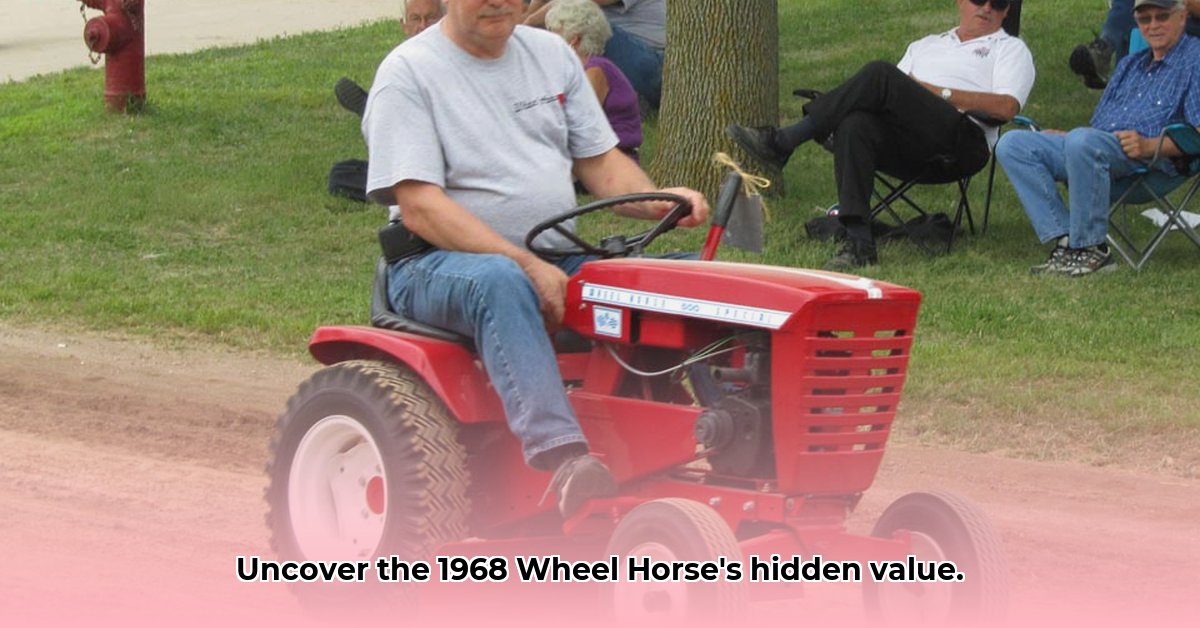
Ever dreamt of owning a piece of Indy 500 history? The 1968 Wheel Horse 500 Special garden tractor offers just that. This rare machine combines iconic design with powerful performance, making it a prized possession for collectors. This comprehensive guide equips you with the knowledge to identify, assess, acquire, and maintain this coveted piece of Americana. Whether you’re a seasoned collector or a curious newcomer, let's delve into the world of the 1968 Wheel Horse 500 Special. For more on vintage tractors, check out this helpful resource: Vintage Tractor Info.
Identifying a Genuine 1968 Wheel Horse 500 Special
Authenticity is paramount. A genuine 1968 Wheel Horse 500 Special boasts several key identifying features. Look for the commemorative Indy 500 decal, typically found on the hood or fenders. The color scheme—usually red and white—is another crucial visual clue, although variations may exist. Under the hood, the 6 HP Tecumseh engine serves as a critical identifying marker. The serial number, located on a specific part of the tractor's frame (consult online resources for its precise location), provides crucial verification. Cross-referencing this number with Wheel Horse records (if accessible) can confirm authenticity. Finally, the original 32-inch mower deck is an essential part of the complete package. A detailed checklist and high-resolution images are invaluable tools for confirming authenticity. Is there anything more rewarding than successfully identifying a rare and valuable machine?
Assessing Condition and Value
Condition significantly influences value. Like classic cars, pristine tractors command top dollar. Original paint, a fully functional engine, and the presence of original components all contribute to the tractor's worth. Damaged or replaced parts lower the value, and poor restoration work can have a substantial negative impact. Careful examination is essential. Assess the condition of the tires, mower deck, engine, and all other moving parts. Evaluate any existing restoration or repair work for quality and appropriateness. Detailed photos and documentation establish a verifiable record of the tractor’s history. How would you rate the importance of meticulous record-keeping in determining a tractor’s value?
Here's a condition and value assessment table:
| Condition Grade | Description | Value Impact |
|---|---|---|
| Excellent | Pristine condition; all original parts; essentially like new. | Highest value; highly collectible |
| Good | Minor wear; mostly original parts; fully functional. | Strong value; highly desirable |
| Fair | Noticeable wear; some parts replaced; still functional. | Moderate value; some work needed |
| Poor | Extensive wear; many parts replaced or missing; non-functional | Low value; mainly for parts |
Locating and Acquiring Your 1968 Wheel Horse 500 Special
The hunt for this rare tractor requires a strategic approach. Begin your search online using dedicated marketplaces for vintage tractors and farm equipment. Online forums and social media groups dedicated to Wheel Horse tractors or classic machinery often feature listings and discussions among knowledgeable collectors. Local auctions can present unexpected opportunities, but conduct thorough inspections and research beforehand. Private sellers can offer a more personalized experience, but careful scrutiny and verification are crucial to avoid scams. Consider joining a Wheel Horse club; these communities offer invaluable resources and networking opportunities. What’s the best way to approach negotiations when purchasing a vintage tractor? Always inspect the tractor in person and verify its authenticity before committing to a purchase.
Restoration and Maintenance: A Labor of Love
Restoring a 1968 Wheel Horse 500 Special is a significant undertaking, requiring time, skill, and resources. Sourcing parts can be challenging. Online marketplaces, specialized suppliers for antique tractor parts, and even parts from similar Wheel Horse models (with appropriate modifications) can be helpful. Common repair issues frequently involve the engine, transmission, and mower deck. Seek out local repair shops specializing in vintage tractors. Honest self-assessment of your mechanical skills is critical. Regular maintenance is vital, extending the tractor's lifespan and preserving its value. What are the most common issues encountered during the restoration of a 1968 Wheel Horse 500 Special?
Preserving Value and Provenance: Documentation is Key
Comprehensive documentation significantly increases your tractor's value. Maintain a detailed history file, including photos of each restoration step and a record of all parts, repairs, and maintenance. Service records and any certificates of authenticity should also be preserved. This documentation creates a verifiable history, providing crucial context for potential future buyers or appraisers. Preserving original parts or accurately documenting any replacements maintains the tractor’s authenticity, increasing its collector value. How does thorough documentation impact the long-term value of a 1968 Wheel Horse 500 Special?
How to Accurately Value a 1968 Wheel Horse 500 Special Tractor
Several factors influence the value:
- Condition and Originality: Pristine, original condition commands the highest value. Significant wear or non-original parts negatively impact pricing.
- Indy 500 Significance: The "Indy 500 Special" designation adds value, reflecting its limited production and connection to the famous race.
- Documentation: A complete history including restoration records, maintenance logs, and photos substantially increases value.
- Market Demand: Current market trends and collector interest influence pricing.
This guide provides a strong foundation for navigating the world of 1968 Wheel Horse 500 Special tractors. Remember, careful research, thorough inspection, and strategic acquisition are crucial steps toward owning this iconic piece of agricultural history.